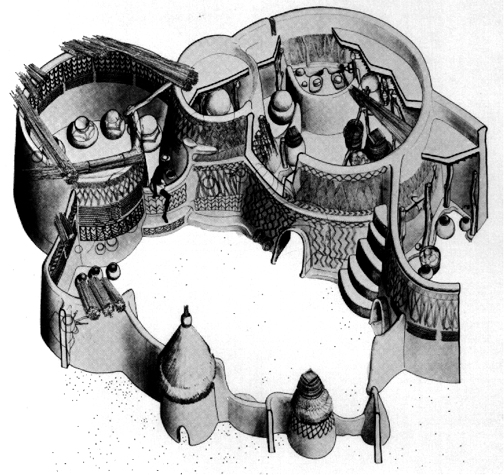
Each woman keeps a stack of
 scaled bowls tied together called a zalanga in her kitchen, with the
smallest bowl being the kumpio, a shrine for her soul. When she dies
the zalanga is broken and her soul is released to eternity. While the
scaling of the architecture maps life from birth to death, the zalanga
models life in reverse—from the circles of the largest bowls to the
tiniest holding the soul, from mature adult to the spiritual realm of
ancestors who dwell in the “earth’s womb”. There is a conscious scheme
to the scaling circle of the Nankani: a recursion that bottoms-out at
infinity, marking the passage of life and death.
scaled bowls tied together called a zalanga in her kitchen, with the
smallest bowl being the kumpio, a shrine for her soul. When she dies
the zalanga is broken and her soul is released to eternity. While the
scaling of the architecture maps life from birth to death, the zalanga
models life in reverse—from the circles of the largest bowls to the
tiniest holding the soul, from mature adult to the spiritual realm of
ancestors who dwell in the “earth’s womb”. There is a conscious scheme
to the scaling circle of the Nankani: a recursion that bottoms-out at
infinity, marking the passage of life and death.
Together with similar compounds, the building complex as a whole is about 20 meters; the kumpio is about 0.2 meters. How many orders of magnitude does this fractal scale across? How does this compare to the orders of magnitude in the Koch curve image?
The homes of the Nankani are fractal series of cylinders. Here we see just one compound, a cylinder of cylinders that get smaller as you rotate counter-clockwise around the central courtyard.
Your first first rite of passage is from mother's womb to the birthing room. Your next is to crawl into the courtyard. Your next is from the court yard to the village as a whole, and finally from the village to the world.